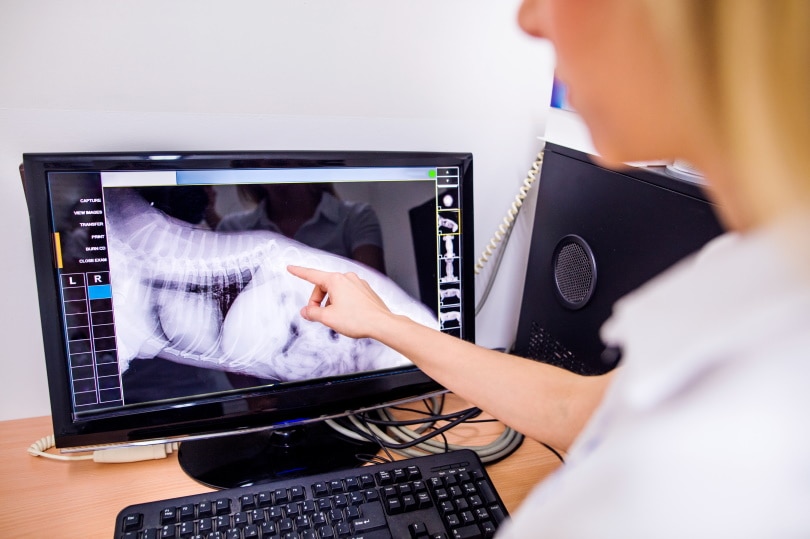In this article
There are many reasons why dogs may need an X-ray. Your dog may have a broken bone or accidentally ingested something it shouldn’t have. X-rays can also alert us to diseases that may be life-threatening and cause unnecessary discomfort for our pets.
Our pets are like family, so we love them and want to keep them healthy and pain-free. When they are ill or injured, the last thing we want to consider is how much it will cost at the vet, but we need to be prepared for unexpected expenses. As a general overview, it can go from $75 to $500 dollars, but it will depend on numerous factors. We’ll break down the cost of a dog X-ray in this article.

The Importance of X-Rays
Standard X-rays are still images used in the diagnostic process to determine if a bone is fractured or identify significant changes in your dog’s organs. In addition to your standard X-rays, which are still images, veterinarians also use other types of imaging:
- Diagnostic medical sonography, or ultrasound, captures the body’s functioning in real time. Ultrasounds performed on dogs are primarily for issues relating to the abdominal cavity or heart.
- Computerized tomography (CT scan) is similar to a standard 2D X-ray with a more advanced 3D view. CT scans can be used for imaging any part of the body, but they are best for detecting head trauma and diagnosing lung and nasal diseases.
- Magnetic resonance imaging (MRI) is used to diagnose and treat a dog’s medical condition. MRIs are used for detecting all types of tissue disease or injury. However, 90% of the time, an MRI is used to provide imaging of the brain and spinal cord.
The type of imaging used depends on what exactly is going on with your dog. But no matter which type of imaging is used, the previous methods are the best way for a vet to figure out exactly what is going on with your dog and how to treat it.
Depending on your pet’s medical issue or injury, an X-ray can be a “one-and-done” situation. But in some instances, they are used routinely to keep an eye on the progression of a disease or for monitoring a difficult pregnancy. So now that you know the importance of X-rays for dogs, let’s look at how much they might cost.
How Much Does an X-Ray Cost?
All types of X-rays or imaging tools help alert your vet to severe injuries that can cause your pet pain, diseases, and illnesses that can be serious or fatal.
The cost of an X-ray can vary greatly. The average you can expect to pay for a standard X-ray is between $150 and $250. However, the range can be between $75 and $500, depending on numerous factors. Some contributing factors to the cost include sedation, how many views the vet requires, and your location.
- An ultrasound can range from $300–$400.
- A CT scan runs between $500–$1,200.
- And an MRI can cost between $1,100–$1,500.
Another thing to consider is whether you are at your vet’s office or an emergency hospital. Having X-rays at an emergency hospital may cost more than at a regular vet’s office.
- Related Read: How Much Does an Emergency Vet Cost for Dogs?

Factors Affecting the Cost of a Dog’s X-Ray
Sedation
- Not all X-rays require sedation. A standard X-ray or an ultrasound does not require sedation. Some vets may hold a dog in place with special padded devices for standard X-rays. However, sedation may be required if the dog is in pain, overly anxious, or having difficulty in certain positions. CT scans and MRIs, however, require sedation, which can raise the price significantly. Anesthesia can run between $60–$100 per half hour.
Size
- The amount of anesthesia required for your dog depends on their weight. So, the size of your dog will determine the cost of sedation if it is necessary, which may increase the total cost of the X-ray.
- The area being X-rayed can affect the price.
- Living in a big city or an area with a higher cost of living can also affect the cost of diagnosing and treating your pet. Living in a rural area could increase the cost since fewer patients can be treated. Your vet has to make money, too!
Veterinarian
- Typically, you will pay less at your local or regular vet. They are usually less expensive than an emergency clinic or hospital. However, the exact price you pay may be influenced by your vet’s experience level and expertise.

Additional Costs to Anticipate
An X-ray is a tool used to diagnose your pet. If your dog needs an X-ray, you should expect to pay other costs associated with the injury or illness. Depending on your dog’s injury or illness, the vet may dispense antibiotics or pain medication or order additional testing.
Your vet will likely recommend performing blood work on your dog’s liver and kidney function before administering anesthesia to ensure they’re healthy enough for sedation. Blood work can cost between $100 and $200.
In cases where the X-ray reveals a tumor or a possible obstruction, your little buddy may need additional treatment to address the underlying cause.
For example, if your pet has a life-threatening bowel obstruction, they may require surgery. This likely includes hospitalization, medication, and sedation. The average cost of bowel obstruction surgery can be $5,000–$8,000.
A tumor may need testing to determine if it’s cancerous or benign, and it may require chemotherapy, radiation, or surgery. It may be necessary to have regular vet visits and routinely pull blood, take an X-ray, and perform testing.
Some of these scenarios may include increased travel and time off from work, which could increase your gas budget and affect your expenses.

How Often Should I Get an X-Ray for My Dog?
We take our dogs to the vet for yearly visits to keep them informed about their overall health. Your vet will likely do bloodwork and fecal exams and administer any shots or treatments your dog needs to keep them free of disease and parasites. Depending on your pet, your vet may recommend yearly dental cleanings and X-rays of your dog’s teeth.
Other instances that may need X-rays regularly may be to monitor the effectiveness of treatment of an organ, the healing process of an injury, or to keep an eye on a dental issue, such as gum disease.

Does Pet Insurance Cover X-Rays?
Pet insurance providers have different plans available that are similar to health insurance plans for humans. Most pet insurance plans cover basic care and diagnostic testing, which includes exams, X-rays, tests, and routine shots that may be required by law. They will also cover accidents, illnesses, and medications needed on a regular basis for chronic illness.
Most pet insurance will cover 80%-90% of the bill. However, it will depend on the company and coverage you purchase. There are also discount plans and emergency plans available.
Do your research and compare different plans and coverages. When deciding whether to purchase any type of insurance or discount plan, it is vital to make an informed decision about the type of coverage you need.

Summary
X-rays are an essential piece of equipment that helps your vet diagnose and treat your dog. There are several variables affecting the cost of an X-ray, but in the case of severe injury or illness, they are necessary for a proper diagnosis. An X-ray may be an unexpected expense, and it may create a temporary financial hardship, but it can prevent future expenses and possibly save your dog’s life. Plus, choosing the right pet insurance plan can help cover the cost.
Featured Image Credit: Halfpoint, Shutterstock



















